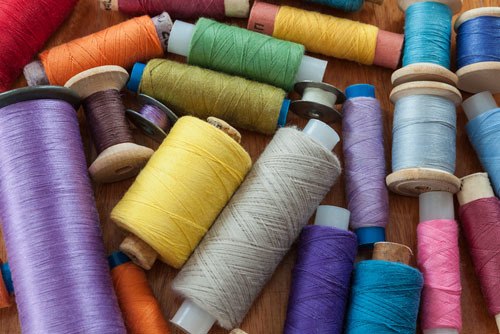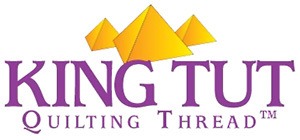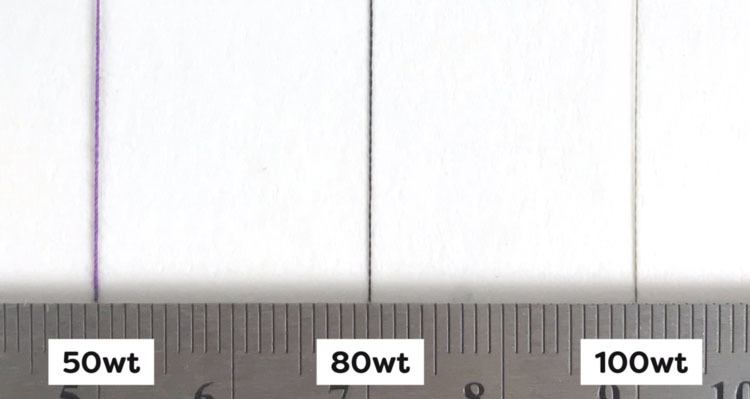
Thread is what holds your quilt together, so the decision of which thread to choose for your next quilt shouldn't be taken lightly. Have you ever stood in your favorite fabric store, overwhelmed with all of the spool options available? You're not alone! Choosing the perfect type, weight, and brand of quilting thread is no quick nor easy decision. 40 weight, 50 weight, 80 weight, what does thread weight even mean? Should I use cotton, polyester, cotton-poly, Egyptian cotton, silk? Ugh, this can get so confusing! We've created this guide to help you fully understand your options, and why each of them can be important for your next quilt. We also created another extensive guide on understanding sewing thread, be sure to check that out also!
Quilting Thread by Brand
There are lots of brands that you can choose from when selecting the perfect thread for your quilting needs. With thread, you get what you pay for. Cheaper brands of thread can cause lots of frustration with your quilt and your sewing machine. I always recommend spending a little bit more money to get a really good brand of thread. My favorite brands of quilting thread are Aurifil, King Tut, and Madeira. For specialty threads, Wonderfil has some really fun options.
Aurifil Thread
Based in Italy, Aurifil specializes in producing some of the highest quality Egyptian Cotton thread that you can find. Aurifil originally marketed their thread for machine embroidery, but quilters worldwide quickly realized that Aurifil Mako Cotton was the perfect thread for piecing and quilting. Aurifil is now the most popular brand of quilting thread in the industry, largely because it produces virtually no lint. Spool sizes range from small 54-yard spools all the way up to huge 6400-yard cones. With hundreds of colors and plenty of different weights to choose from, we believe that Aurifil may be the answer to the common question, "What's the best thread for quilting?"
Coats & Clark Thread
Coats & Clark 100% Cotton Quilting Thread is a wonderful option if you are looking for a quality quilting thread, while on a budget. The natural fibers provide little stretch and have a silky, yet durable finish.
Gutermann Thread
The 100% Natural Cotton Gutermann Thread is ideal for the quilter that wants to sew with natural material. The 30 wt Gutermann Quilting thread is fine, yet strong. It has a wonderful silky finish. This high-quality cotton thread can be used for hand sewing, in addition to machine sewing. It is perfect for a longarm machine. 100% long-staple mercerized cotton threads are a must for your sewing room.
King Tut Thread
Some quilters consider King Tut to be the gold standard of quilting thread. Each spool is made from extra-long-staple Egyptian cotton, making it practically lint-free. Due to its lack of memory, King Tut doesn't tangle or knot like other lesser quality threads. Available in both 500 and 2,000-yard spools, King Tut is a near-perfect 40 weight 3 ply quilting thread.
Madeira Thread
To achieve a beautiful matte finish with a natural look, Madeira Cotona No. 30 is for you. This thread is an extra-long staple, double mercerized Egyptian cotton. Its high tensile strength is perfect for applique, machine quilting, and piecing. The quality of Madeira thread allows for beautiful topstitching, applique, and cross-stitching.
Signature Thread
Signature Quilting thread is a gorgeous 3 ply, long-staple cotton quilting thread. The mercerized cotton ensures low lint and superior strength. This quality thread produces a beautiful stitch, whether you are using a home machine or a long arm machine. This product has a beautiful finish that every quilter can appreciate.

Wonderfil Thread
Wonderfil is the leader when it comes to specialty threads! For decorative quilting, check out their lines of Efina, Spotlite, Glamore, and Splendor. Konfetti, Tutti, Mirage, and Master Quilter are the perfect thread for free-motion quilting. Finally, if you're looking for what they offer for longarm quilting, you can't go wrong with Ultima, Spagetti, Fruitti, and FabuLux. Wonderfil offers an endless selection of quilting threads that perfectly show off your quilts and projects.

Quilting Thread by Weight
If you feel confused when talking about thread weight, you're not alone! Lots of people don't fully understand how to gauge which weight they need for specific quilts. Lower numbers mean the thread is thicker, and higher numbers mean the thread is thinner. Thicker thread weights (think 40 weight or 30 weight) stand out and pop more than the thinner weights. Remember that thread weight can affect the tension of your machine. When you change thread weights, you may need to adjust the machine's tension.
12 Weight Quilting Thread
This heavier-weight thread is great for accomplishing many different types of fun projects. Hand applique and hand embroidery are popular; however, my favorite is utilizing it to create some fun designs with machine or long arm quilting. 12wt thread is the largest size of thread that you can safely use with your home sewing machine. Although most machines are set up to use a 40wt or 50wt thread, you can have a lot of fun with a 12wt thread by just making a few adjustments.
First, do yourself a favor and use the correct needle. I have heard so many people ask, “it can’t make THAT much of a difference?!” Believe me, you will save yourself time and a headache if you do this. A topstitch needle is perfect as it has a wider opening where the thread passes through. Some refer to this as a “larger eye”. This wider opening allows the heavier 12wt thread to more easily move in the eye and it helps avoid friction. This creates less breakage and prevents skipped stitches--saving you time AND the headache I was talking about.
You will want to play with your tension. Unfortunately, there is not an exact setting that I can give you. I recommend sewing on test strips prior to sewing on your actual project. This allows you to play around and see which settings produce the best result. Another setting to consider playing with is your stitch length. I think it looks prettier with a little larger stitch length. A 3 or 3.5 stitch length, versus a 2.5, to me, looks cleaner. Ultimately, this is completely up to you and your preferences!
Also, a good thing to mention is the bobbin thread. Although your needle thread is 12wt, you will want to use a 40 or 50wt in the bobbin. Lastly, take your time. Go slow. The heavier thread can be a little tricky at first, but you will be creating chunky- beautiful work in no time with these easy techniques.
Recommended Needle: 100/16 or 90/14 Topstitch needle
28 Weight Quilting Thread
As with the heavier 12wt thread, the 28wt thread can also be used to create some lovely projects. Hand quilting and hand applique are always fun options. It can also be used for double-strand cross stitch, textured long arm quilting, machine embroidery, and machine quilting. Blanket stitch and lower looper serging can also be accomplished with this weight of thread. One thing that I really love about using the 28wt thread is that it is less chunky than the 12wt thread, but it still gives you a nice visual “punch!”
It makes a beautiful impact when you pick a contrasting color thread from your fabric. Again, I suggest using a slightly longer stitch length and being sure to make certain that you are using the correct needle. With the 28wt thread, a quilting, denim, or topstitch needle works nicely. Practice on your test strip. I know, I know, I sound like a broken record! But seriously, save yourself money on Tylenol and always make sure you run your little tests.
Recommended Needle: 90/14 Quilting, Denim, or Topstitch needle (use 40wt or 50wt thread in the bobbin)
40 Weight Quilting Thread
Now we are getting to good ol’ 40wt. Everyone loves a good quality 40wt thread. In addition to being a great weight for hand piecing, machine lace work, machine applique, and machine embroidery, it is a staple for longarm quilting. Ps. Don’t forget it can be used for single, double, and triple strand cross stitch too. ;) Back to quilting...the reason that this weight is so loved is, oftentimes, you want your piecing to be the focus and you want actual quilting to be less of the aforementioned “visual punch.” This can be accomplished by choosing a nice neutral color and using a little lighter-weight thread. You're sure to produce some lovely results.
Recommended Needle: 80/12 Universal, Microtex/Sharp, or Denim needle 75/11 or 90/14 Quilting needle (use 40wt or 50wt thread in the bobbin)
50 Weight Quilting Thread
50wt thread is probably the most versatile thread weight! Because it is so popular, you can often find an exorbitant amount of color options. How fun is that!? It is fantastic for basting! Hand piecing, needle turn applique, and machine quilting can also be accomplished with this weight of thread. Since it is such a fundamental thread weight, it doesn’t hurt to have a nice- LARGE- variety of spools to choose from. It’s kind of like when you find a style of shirt that you just LOVE! Keep many on hand!
Recommended Needle: 80/12 Universal, Microtex/Sharp, or Denim needle (use 50wt thread in the bobbin)
80 Weight Quilting Thread
Free motion quilting and free-motion couching are so fun. Am I right?! I love the wavy lines and swirls. The freedom of it is what is so enticing. Don’t ruin that free-flowing freedom by choosing the wrong thread. An 80wt thread is perfect for this technique. My broken record is playing again--make sure you test your creative designs on a test piece and then you can get to quilting! Don’t forget, you can also use this thread weight for applique, English paper piecing, and machine embroidery.
Recommended Needle: 70/10 or 80/12 Embroidery or Microtex/Sharp needle (use 80wt in the bobbin)

Quilting Thread by Material
Well, we've learned about the many different brands of quilting thread, along with how to determine which weight needs to be used for the specific type of quilting you'll be doing. Now we will jump into learning how to choose the correct material of thread! With so many types of thread material to choose from, it may leave your head spinning. We have broken down the different types of options below, with some pros and cons.
Cotton Thread
As many people know, quilters usually gravitate towards using 100% cotton thread for all of their quilt construction. Cotton thread is made with natural fibers, so the cost of spools will be slightly higher than a similar quality polyester. Due to its non-reflective matte finish, cotton thread blends into the fabric better than other materials of thread. Another benefit to using cotton is the zero stretch nature of the thread. This means that you don't have to worry about the quilt puckering after it's been washed!
Polyester Thread
Polyester thread is a much newer type of thread made up of synthetic fibers, so the cost of spools will be slightly lower than similar quality cotton. Besides the cost advantage of poly, its level of strength is also a nice advantage. This allows you to use a thinner weight thread than if using cotton, so you can hide the stitch inside the fabric more easily. The polyester vs cotton thread debate will never be finished, but ultimately the decision is up to you.
Silk Thread
Silk thread is going to be the most expensive choice when choosing which thread to use, but the results will be extraordinary. Having smooth and lint-free fibers, silk is a wonderful thread option for quilting. Be sure to start small with a 60/8 Microtex needle, and move up to a slightly larger needle if the thread shreds or the needle breaks. If you want to save money, use Aurifil's 50 weight cotton in your bobbin. Give silk thread a try in your next quilt, the results will blow you away.
Rayon Thread
In my opinion, Rayon is a good mix between silk and polyester. It has a high sheen which can help your quilt turn out beautifully, without the added cost of choosing a silk thread. Rayon thread will perform pretty well in your sewing machine with little fraying or breaking. We don’t recommend Rayon thread for seam construction because it’s not as strong as the other options and becomes even weaker when wet.
Wrapping Up
Well, I hope you learned a lot from our Ultimate Quilting Thread Guide! There are definitely lots of choices to make when selecting the perfect thread for your next quilt. In the end, I don't think there's a 'wrong answer', just lots of personal preferences. Let us know in the comments what your go-to quilting thread is.















